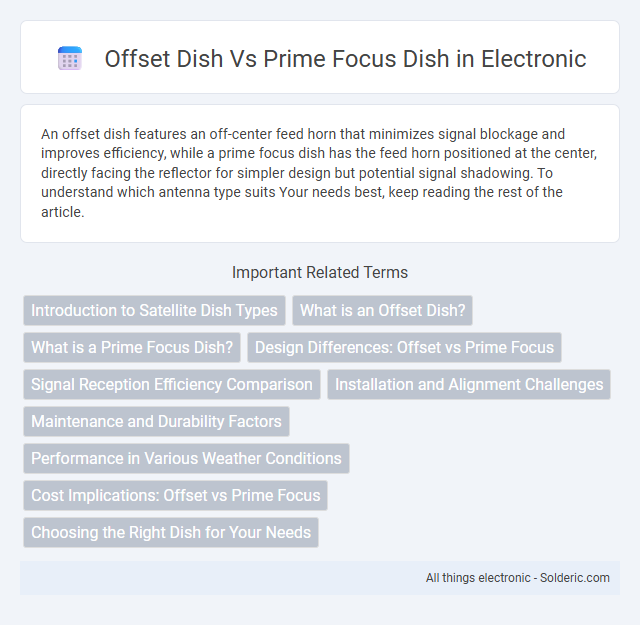An offset dish features an off-center feed horn that minimizes signal blockage and improves efficiency, while a prime focus dish has the feed horn positioned at the center, directly facing the reflector for simpler design but potential signal shadowing. To understand which antenna type suits Your needs best, keep reading the rest of the article.
Comparison Table
| Feature | Offset Dish | Prime Focus Dish |
|---|---|---|
| Design | Asymmetrical reflector; feed located off-axis | Symmetrical parabolic reflector; feed located at the focal point |
| Aperture Efficiency | Higher; reduced blockage improves signal | Lower; feed and support structure cause blockage |
| Signal Blockage | Minimal; feed and supports outside main aperture | Significant feed blockage in reflective path |
| Cross-Polarization | Lower; better polarization purity | Higher; more cross-polarization effects |
| Mechanical Complexity | More complex mounting and alignment | Simpler structure and feed placement |
| Applications | Satellite communication, deep-space antennas | Radio telescopes, smaller satellite dishes |
| Cost | Higher due to complex design and fabrication | Lower, simpler manufacturing |
| Size and Profile | Lower profile; easier installation in limited spaces | Higher profile; feed located at dish center |
Introduction to Satellite Dish Types
Offset dishes feature a feed horn positioned off-center, minimizing signal blockage and providing better performance in urban areas with limited space. Prime focus dishes have a feed horn located at the parabola's focal point, offering simplicity and high gain but requiring more clearance around the dish. Understanding these differences helps you choose the best satellite dish type for your specific installation environment and signal strength needs.
What is an Offset Dish?
An offset dish is a type of satellite antenna designed with the feed horn positioned off-center to avoid blocking the main reflector, resulting in improved signal reception and reduced interference. This design contrasts with prime focus dishes, where the feed is located at the dish's focal point, directly aligned with the reflector's center, causing some signal obstruction. Offset dishes are popular in residential satellite TV systems due to their compact size and enhanced performance in capturing weaker signals.
What is a Prime Focus Dish?
A Prime Focus Dish is a type of parabolic antenna where the feed horn is positioned directly at the focal point of the dish, maximizing signal strength and minimizing loss. This design allows for a straightforward, compact setup ideal for satellite communication and radio telescopes. Your choice of a prime focus dish often hinges on achieving optimal signal quality with simple alignment requirements.
Design Differences: Offset vs Prime Focus
Offset dishes feature a reflector designed as a section of a paraboloid, angled away from the feed arm to prevent signal obstruction and reduce noise, enhancing signal quality. Prime focus dishes position the feed horn directly at the reflector's focal point, resulting in a symmetric paraboloid shape where the feed and its support structure can cause slight signal blockage and increased sidelobes. Your choice depends on the need for clearer signal reception with offset dishes or the simplicity and compactness offered by prime focus designs.
Signal Reception Efficiency Comparison
Offset dishes demonstrate higher signal reception efficiency compared to prime focus dishes due to their asymmetrical design, which minimizes feed block shadowing and reduces signal blockage. Prime focus dishes, while simpler in construction, experience more signal obstruction as the feed horn is positioned directly in the path of incoming signals, leading to slightly lower gain and increased noise. This difference generally results in offset dishes providing clearer, stronger satellite signal reception, especially in environments requiring high sensitivity.
Installation and Alignment Challenges
Offset dishes require more precise installation and alignment due to their asymmetrical design, which can cause signal distortion if not accurately positioned. Prime focus dishes tend to be easier to install and align because their symmetrical shape allows for more straightforward aiming at satellites. Ensuring proper alignment of your dish is crucial for optimal signal reception and performance.
Maintenance and Durability Factors
Offset dishes offer easier maintenance access due to their tilted design, reducing debris accumulation and water pooling, which enhances long-term durability. Prime focus dishes, while generally robust, require more frequent cleaning and alignment checks because their straight-on positioning collects more dust and rainwater. You'll find offset dishes often provide lower maintenance costs and greater resilience in harsh weather conditions, making them a preferred choice for durability.
Performance in Various Weather Conditions
Offset dishes generally outperform prime focus dishes in adverse weather conditions due to their design minimizing signal blockage from rain, snow, and wind. Prime focus dishes are more susceptible to signal degradation from precipitation and strong winds because the feed horn is positioned at the center, which can create additional interference. Your best choice depends on your local climate, but offset dishes deliver better signal reliability and performance in varied weather environments.
Cost Implications: Offset vs Prime Focus
Offset dishes generally have higher manufacturing and installation costs due to their complex shapes and precise alignment requirements, but they offer better signal quality by minimizing interference and noise. Prime focus dishes tend to be more cost-effective initially, with simpler designs and easier construction, but may require more frequent maintenance and adjustments due to their exposure to feed blockage and shadowing. Your choice between offset and prime focus dishes should balance budget constraints with performance needs, especially in applications demanding consistent signal strength and low noise.
Choosing the Right Dish for Your Needs
Selecting between an offset dish and a prime focus dish depends on your space constraints and signal requirements. Offset dishes feature a tilted feed horn that avoids obstruction, providing a cleaner signal and easier installation in limited spaces. Your choice should consider installation location, signal strength, and maintenance preferences to optimize reception.
offset dish vs prime focus dish Infographic

 solderic.com
solderic.com